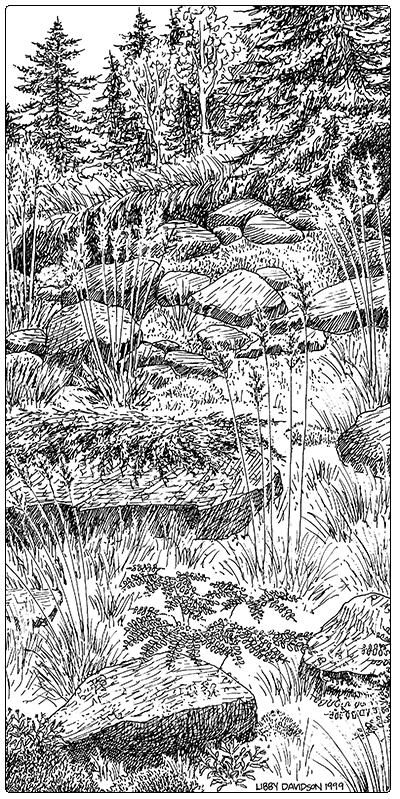Ecology and Physical Setting
Serpentine Outcrops are areas of exposed ultramafic bedrock. Serpentine is a term used to describe a broad class of ultramafic rocks and also the soils derived from them. Ultramafic rock originated deep in the earth’s mantle, so it has more in common chemically with that layer of the earth than with the crust. Chemically, these rocks are very different from other Vermont rocks. Iron and magnesium are abundant, as are nickel and chromium, metals that are toxic to plants in high concentrations. At the same time, important plant nutrients such as calcium, nitrogen, phosphorus, potassium, and molybdenum are all in short supply in serpentine soils. The ratio of calcium to magnesium is also unusually low. This particular chemical environment creates challenges for many plants and makes Serpentine Outcrops quite different from other kinds of outcrops. Indeed, in other parts of the country where serpentine occurs, the habitat has fostered the evolution of serpentine-adapted species, plants that apparently can grow nowhere else. In Vermont and adjacent Québec, the effect of serpentine is mostly to create a harsh habitat where many common plants cannot survive.
Ultramafic rock takes on different forms in Vermont. Serpentinite is a class that includes a greenish, fibrous rock that was mined for asbestos in Lowell and Eden, as well as so-called serpentine marble or verde antique which has been mined in Rochester. Dunite is a type of peridotite that is a brownish, coarse-grained rock that is found occasionally in Westfield and Troy.
Vegetation
Serpentine Outcrops, like other kinds of outcrops and cliffs, are sparsely vegetated communities, with scattered plants growing in the soil that accumulates in the cracks in the rock. Grasses such as hairgrass, and other herbs such as field chickweed, are common. Shrubs such as common juniper and Labrador tea, and occasional trees, are present as well. The overall diversity of species is low because of the limited number of plants that can tolerate the specialized habitat. Several rare plants are restricted to this community in Vermont. The Green Mountain maidenhair fern grows only on serpentine soils, and its overall distribution is limited to northern Vermont and southern Québec. Serpentine sandwort and serpentine maidenhair fern are two other appropriately named rare species, which, in Vermont, are found only on these outcrops.
Wildlife Habitat
Little is known about the wildlife species that use Serpentine Outcrops in Vermont. Since our examples are all small, wildlife observed are most likely associated with the surrounding forests, primarily spruce and fir. White-throated sparrows may nest on the ground in areas concealed by patches of dense shrubs or small trees. Red squirrels or their piles of cones and scales are a common sight. In western North America, several studies have identified ants, butterflies, daddy-long-legs, and leaf beetles that are dependent on some of the specialized plants that are adapted to grow on serpentine outcrops.
Related Communities
- Temperate Acidic Outcrop is similar in structure and composition but lacks the serpentine specialists and has warm-climate species such as cow-wheat, bastard toadflax, and little bluestem.
- Boreal Outcrop is similar in structure and composition but lacks the serpentine specialists.
Conservation Status and Management Considerations
Serpentine rock is the source of asbestos and also verde antique, an architectural stone. Although quarrying for these products can create additional habitat for some of the rare plants associated with serpentine rock, it disrupts the functioning of the natural community. One important Serpentine Outcrop is protected by The Nature Conservancy, and another example is protected on public land.
Distribution/Abundance
In Vermont, Serpentine Outcrops are found mostly in the Green Mountains, somewhat east of the main ridge. Significant areas are found in the north, in the towns of Eden, Troy, Lowell, and Westfield. Serpentine rock outcrops occur in small patches all along the Appalachians, from Newfoundland south to Georgia.
Characteristic Plants
Trees
Red spruce – Picea rubens
Gray birch – Betula populifolia
Shrubs
Common juniper – Juniperus communis var. depressa
Velvetleaf blueberry – Vaccinium myrtilloides
Labrador tea – Rhododendron groenlandicum
Wild raisin – Viburnum nudum var. cassinoides
Herbs
Harebell – Campanula rotundifolia
Field chickweed – Cerastium arvense
Hairgrass – Deschampsia flexuosa
Rock sandwort – Minuartia michauxii
Marginal wood fern – Dryopteris marginalis
Poverty grass – Danthonia spicata
Appalachian polypody – Polypodium appalachianum
Rusty woodsia – Woodsia ilvensis
Maidenhair spleenwort – Asplenium trichomanes
Non-native Plants
Canada bluegrass – Poa compressa
Rare and Uncommon Plants
Green Mountain maidenhair fern – Adiantum viridimontanum
Serpentine maidenhair fern – Adiantum aleuticum
Large-leaved sandwort – Moehringia macrophylla
Serpentine sandwort – Minuartia marcescens
Associated Animals
Red squirrel – Tamiasciurus hudsonicus
White-throated sparrow – Zonotrichia albicollis
Places to Visit
Haystack Mountain, Lowell, Long Trail State Forest, Vermont Department of Forests, Parks, and Recreation
